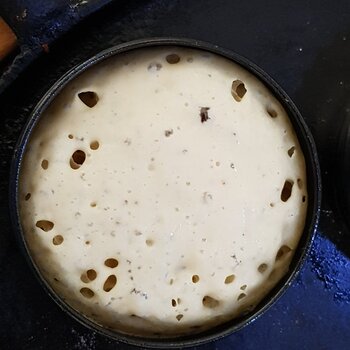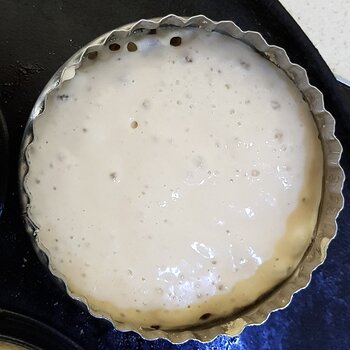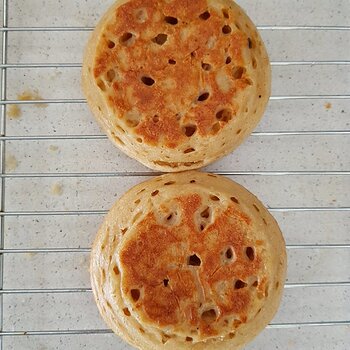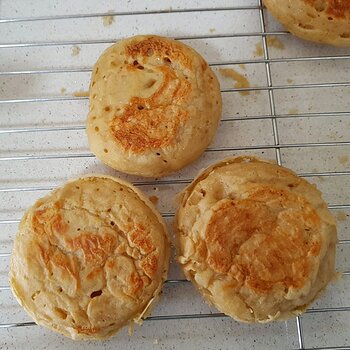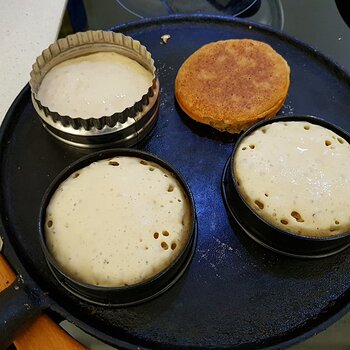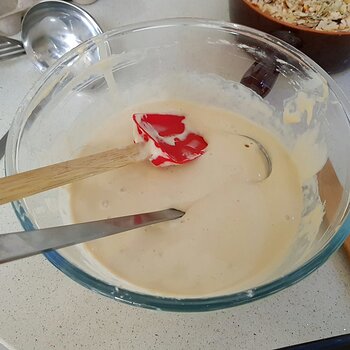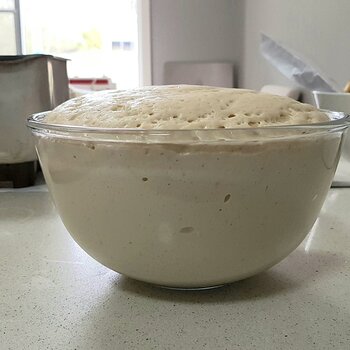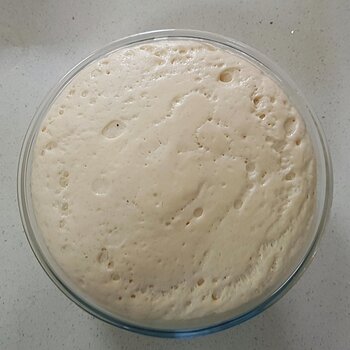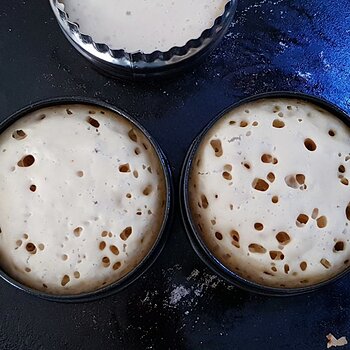- Joined
- 11 Oct 2012
- Local time
- 3:40 PM
- Messages
- 21,839
- Location
- SE Australia
- Website
- www.satnavsaysstraighton.com
I happened to chance upon somewhere selling fresh yeast recently and having promised hubby sometime ago that I would make him some crumpets, I have taken the opportunity to try to different recipes out. I did have a crumpets recipe years ago that made excellent crumpets and can't remember having any problems with it. I know it also used fresh yeast, so I was a little surprised at some of the issues I ran into.
This is the first one, from The Guardian (Perfect Crumpets) and I have to say, just from a cooking point of view I have run into a whole load of issues with the recipe from the word go. The Guardian recipe calls for 150g strong white flour and 100g plain flour. Well I don't have any strong flour of any kind, so had to use all plain flour. Obviously I can't use the 200ml of whole milk the recipe calls for but know that substituting soya milk often works so used 200ml organic soya milk (not almond milk because it is one of those times where it just wont work). And obviously because I wanted to use fresh yeast I needed some conversion tables for the various dried yeasts to fresh yeast (though usually they are working the other way). In the end I went with the Dove's Farm (A UK company I knew well from having lived in the UK most of my life) one which can be found here (Yeast Conversion Table).
You do really need something in the way of crumpet rings to make these, though I have found that circular pastry cutters (not the crinkle ones or side) can double as a single crumpet ring. You'll benefit from at least 2.
This recipe also made a ridiculously thick batter, closer to a wet dough than a thick batter really. I added between 75-100ml extra soya milk/water mixture to the batter to thin it to the required thickness. I have luckily made crumpets before so know what I was aiming for.
Ingredients (Serves 4)
1 tsp sugar
200ml soya milk
100ml boiling water
25g fresh yeast
250g plain flour
1 tsp salt
1/2 tsp bicarbonate of soda
Method
This is the first one, from The Guardian (Perfect Crumpets) and I have to say, just from a cooking point of view I have run into a whole load of issues with the recipe from the word go. The Guardian recipe calls for 150g strong white flour and 100g plain flour. Well I don't have any strong flour of any kind, so had to use all plain flour. Obviously I can't use the 200ml of whole milk the recipe calls for but know that substituting soya milk often works so used 200ml organic soya milk (not almond milk because it is one of those times where it just wont work). And obviously because I wanted to use fresh yeast I needed some conversion tables for the various dried yeasts to fresh yeast (though usually they are working the other way). In the end I went with the Dove's Farm (A UK company I knew well from having lived in the UK most of my life) one which can be found here (Yeast Conversion Table).
You do really need something in the way of crumpet rings to make these, though I have found that circular pastry cutters (not the crinkle ones or side) can double as a single crumpet ring. You'll benefit from at least 2.
This recipe also made a ridiculously thick batter, closer to a wet dough than a thick batter really. I added between 75-100ml extra soya milk/water mixture to the batter to thin it to the required thickness. I have luckily made crumpets before so know what I was aiming for.
Ingredients (Serves 4)
1 tsp sugar
200ml soya milk
100ml boiling water
25g fresh yeast
250g plain flour
1 tsp salt
1/2 tsp bicarbonate of soda
Method
- Beat the sugar and the yeast together into a paste. In another container, mix the cold soya milk with the boiling water and slowly add to the yeast, beating until the yeast thins into a liquid. Add in the remaining soya milk/water, stir and leave in a warm place for 15 minutes until frothy.
- Mix flour with the salt in a large bowl (or in the mixer) and slowly stir in the yeast mixture. Beat until smooth and no pockets of flour remain. Now cover with a clean tea-towel and leave in a warm place for between one to two hours until the batter has doubled in size.
- Dissolve the bicarbonate of soda in 50ml warm water and stir it into the batter. You'll lose all the bubbles, but that is necessary. Cover it over again and leave in a warm place for 30 minutes.
- Heat your griddle over a medium-low heat, lightly grease (with a bland oil such as rapeseed/canola) both griddle and crumpet rings if necessary, but try to limit the amount because it will make the crumpets greasy if you are not careful. Remove any excess with something absorbent.
- Now, check how thick your batter is. It should not be thick enough to look like dough which this recipe did for me. It should also not hold its own shape, but at the same time, it should not be watery. Cautiously add more soya milk/water as needed, beating each time and testing. It should almost hold away from the edge of the bowl when you run the spatula around but not quite. You are looking at it being just thin enough that it will spread out to fill the crumpet rings when you put batter in them. If it is not doing this and you are having to tease it to the edges, it is too thick. Also (though more relative to the next stage of cooking) if you don't get the classic crumpet holes bursting open on the top of the crumpet, the batter is still too thick!
- Put the crumpet rings flat into the griddle and allow them to warm up. Now spoon a small ladleful of batter into each, so they are roughly half full and leave them alone until the top is totally cooked and 'dry'. The batter should not come away if you were to touch the top with a metal spoon...
- Cook until the top is dry and festooned with holes, then push the crumpets out of the rings (you may need a knife for this part and if it is a fight, you have done it too soon).
- Turn the crumpet over and cook on the other side until lightly browned, then transfer to a cooling rack. Crumpets are invariable best left to cool first and then reheated - don't ask why, they just taste so much better if left to cool and then toasted.
Last edited:

